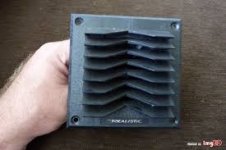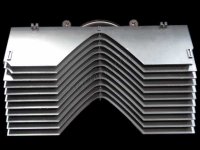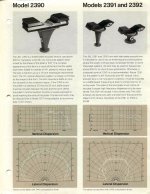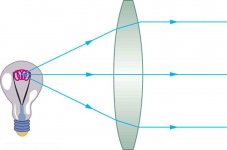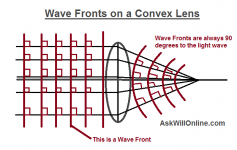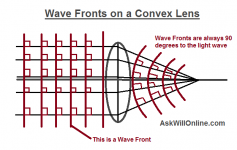Hi, I read an article explaining this type of old fashioned "waveguide" some time ago:
- smth. like window blinds right in front of the twitter.
It consists of horizontal "boards" at an angle of mby 45 degrees. Extended in front of the panel.
How is that called? I want to find the article and re-read the explanation about it.
This is an example of it, but there are slightly different shapes as well.

Regards
- smth. like window blinds right in front of the twitter.
It consists of horizontal "boards" at an angle of mby 45 degrees. Extended in front of the panel.
How is that called? I want to find the article and re-read the explanation about it.
This is an example of it, but there are slightly different shapes as well.

Regards
Last edited:
Disperses the sound to stop beaming of high frquencies.Yes, what it does?
I guess it works similar to an optic lens. The sloped plates cause the speed of sound (in forward direction) to be lower than in air. In optics, glass does the same to the speed of light. These lenses have a similar shape to a negative optic lens. If they are mounted to a horn (= point source located at the compression driver), I expect them to widen the dispersion.
Last edited:
The function is to control the dispersion of high frequencies. More accurately it converts a single point sound source into a parallel wavefront - similar to the way a convex lens can convert the light from a point source into a parallel beam.Judging by the shape, it should widen the dispersion.
P.S. I'm basically agreeing with you TBTL!
Last edited:
That was inaccurate! I should have said 'Controls the dispersion of high frequencies'!Disperses the sound to stop beaming of high frquencies.
Thx  .
.
Seems it attempts to create a parallel beam of sound into the horizontal plane (the vertical dispersion diagram).
Could that solve or ease a particular problem?
- I have a midbass and twitter not centered to a distance of one wavelength the crossover frequeny.
According to some sources, it is better to position them at 1/2 the wavelength distance.
Both ways imposible at xover frequency of 5k ~7 cm c/c distance.
Seems it attempts to create a parallel beam of sound into the horizontal plane (the vertical dispersion diagram).
Could that solve or ease a particular problem?
- I have a midbass and twitter not centered to a distance of one wavelength the crossover frequeny.
According to some sources, it is better to position them at 1/2 the wavelength distance.
Both ways imposible at xover frequency of 5k ~7 cm c/c distance.
The spherical wavefronts from the point sound are diverging outwards and this would result in wide dispersion.It widens dispersion.
The acoustic lens converts the diverging wavefronts into parallel wavefronts which results in a more controlled and uniform dispersion.
Isn't it the case, as emosms has just said, that the acoustic lens gives a uniform horizontal dispersion while narrowing the vertical dispersion?
Isn't this dispersion pattern extremely useful in PA for proper audience coverage of high fequencies?
Attachments
There was a hifi version of the PA type, I saw it 25 years ago in a store, it was already old technology... I love the honeycomb pattern although, from what I heard on youtube, it is made of wood and very costly. Sounds terrific through headphones on youtube..

THere is a new company that upgraded the design and made it sound better, cannot find it now.
An externally hosted image should be here but it was not working when we last tested it.

THere is a new company that upgraded the design and made it sound better, cannot find it now.
Last edited:
If I'm reading it correctly, the narrowed vertical dispersion would prevent treble energy being wasted through being directed towards the ceiling or the floor.Could that solve or ease a particular problem?
Your photos show multicellular horns.There was a hifi version of the PA type, I saw it 25 years ago in a store, it was already old technology... I love the honeycomb pattern
Acoustic Horn | Harvard Natural Sciences Lecture DemonstrationsThe multicellular horn is a cluster of smaller exponential horns, each with a small mouth to avoid beaming in a large frequency range, but together they form a sector of a sphere large enough to control directivity at low frequencies — the cluster acts as one big horn at low frequencies. At high frequecies the individual horns start to beam, but because they are distributed in an arc, coverage is still quite uniform.
Your photos show multicellular horns.
Your pics show light, not sound.
Sound travels very slow compared to light.
Different reality perception & organization
- Status
- This old topic is closed. If you want to reopen this topic, contact a moderator using the "Report Post" button.
- Home
- Loudspeakers
- Multi-Way
- tweeter with blinds-like waveguide
